Cleveland is one of the largest cities in Ohio and one of the leading industrial centers of the United States. Cleveland lies on the southern shore of Lake Erie, at the mouth of the Cuyahoga River. These waterways and the city’s location near huge supplies of coal and iron ore helped make Cleveland an important steel producer. The city also ranks as a transportation, medical, and cultural center of the Midwest and a chief port of the Great Lakes.
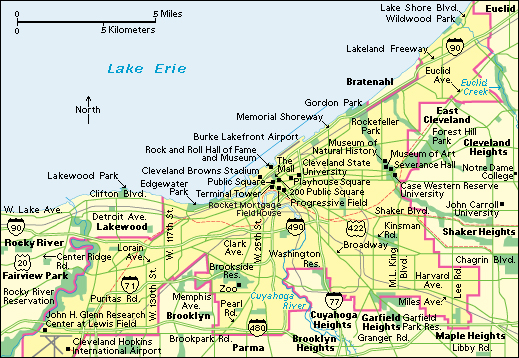
Moses Cleaveland, a surveyor, founded Cleveland in 1796. The village was named for Cleaveland, but a newspaper printer misspelled the name in 1831 and it has been known as Cleveland ever since.
The city
A valley formed by the Cuyahoga River divides the city of Cleveland into an East Side and a West Side. Iron and steel mills and other plants operate in the valley, which is known as the Flats. The part of the Flats near where the Cuyahoga flows into Lake Erie has been redeveloped into a thriving entertainment district.
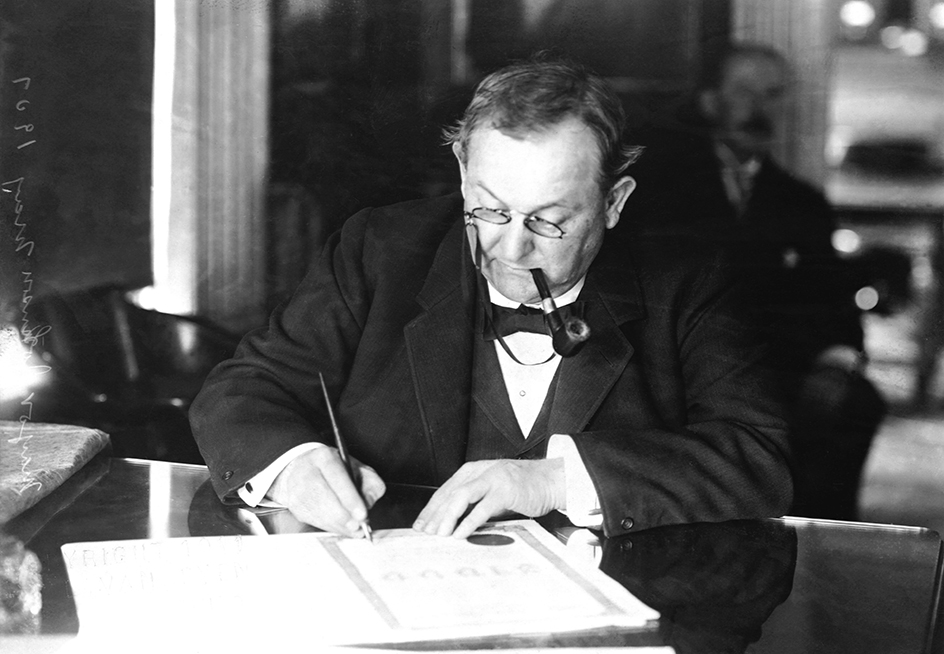
Downtown Cleveland.
The layout for Cleveland’s downtown area was part of a plan developed in the early 1900’s by a commission headed by architect and city planner Daniel Burnham. In keeping with the commission’s plan, Cleveland’s public buildings border a large green space called the Mall. These buildings include the Cuyahoga County Court House, City Hall, the Huntington Convention Center of Cleveland, and the Public Library.
Public Square, which lies near the Mall, covers about 10 acres (4 hectares). The city’s founder, Moses Cleaveland, had set aside the land for use as a town square. A statue of Cleaveland stands in the square, along with the Civil War Soldiers and Sailors Monument and a statue of Tom L. Johnson, a progressive mayor of the early 1900’s. During the winter holidays, the square features an ice skating rink and colorfully lighted displays. During the summer, it serves as a site for outdoor entertainment events.

Public Square is framed by high-rise office buildings, including the Terminal Tower Building, a city landmark. The Terminal Tower Building rises 708 feet (216 meters) at the southwest corner of the square. Tower City Center, a part of the Terminal Tower complex, includes shops, restaurants, a hotel, and offices. It is also a hub for the rapid transit system.
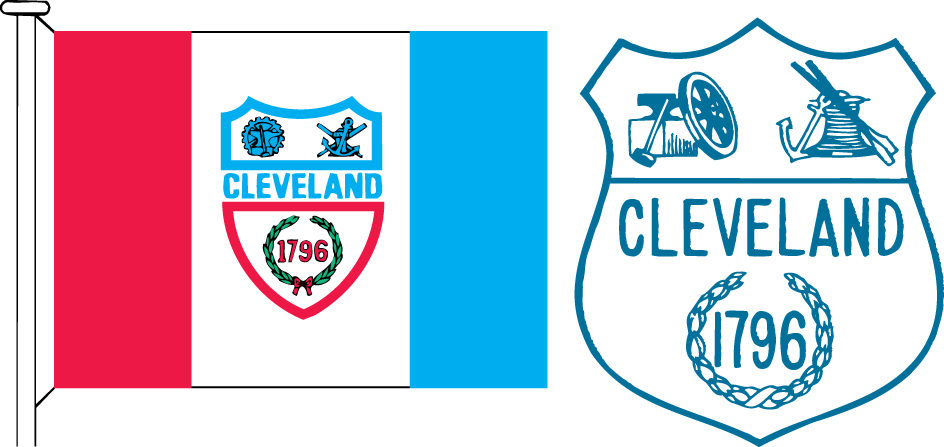
Cleveland’s downtown lakefront underwent extensive redevelopment in the late 1900’s. Its attractions include a sports stadium, a science museum, and the Rock and Roll Hall of Fame and Museum.
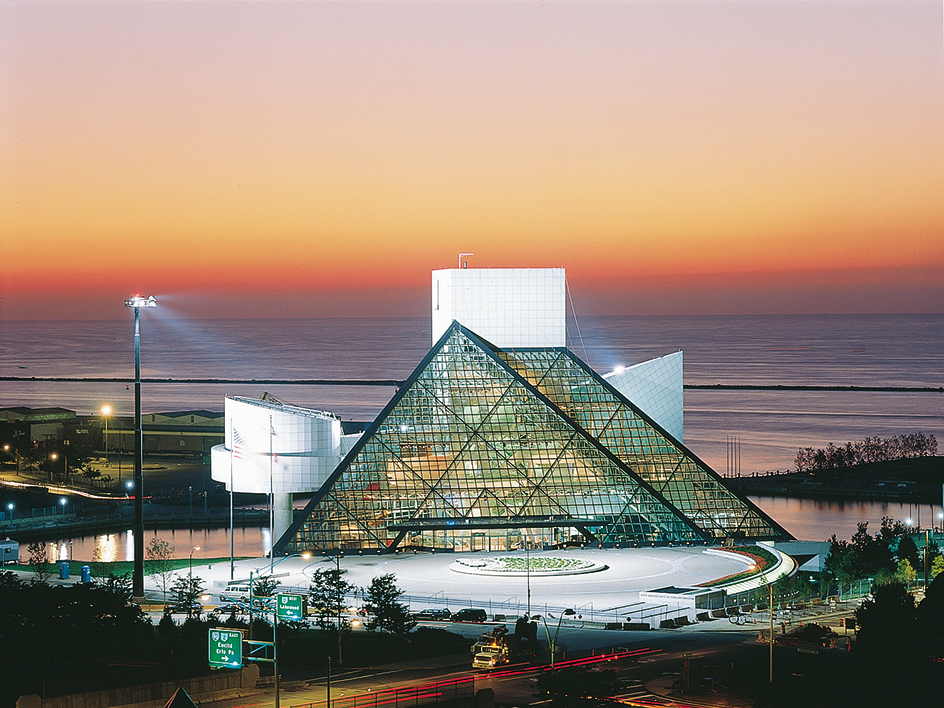
The neighborhoods.
Cleveland has about 35 neighborhoods. These residential areas spread outward from the downtown district. Like many other cities, Cleveland began experiencing decline in its neighborhoods in the mid-1900’s. The decline continued for many years. But in the late 1900’s, Cleveland’s neighborhoods became the focus of redevelopment and revitalization efforts. These efforts included building new housing and neighborhood shopping centers, and resurfacing neighborhood streets.
The metropolitan area
of Cleveland extends over six counties—Ashtabula, Cuyahoga, Geauga, Lake, Lorain, and Medina. Large communities in the Cleveland area include Cleveland Heights, Euclid, Elyria, Lakewood, Lorain, Mentor, Parma, and Strongsville.
The Cleveland metropolitan area began to form in the early part of the 1900’s, when middle- and upper-income families moving outward from the central city established a ring of suburbs around Cleveland. These communities included Cleveland Heights, East Cleveland, Euclid, Garfield Heights, Lakewood, Parma, and Shaker Heights. After World War II ended in 1945, the outward migration increased, and additional rings of suburbs were developed. Such communities as Beachwood, Solon, Strongsville, and Westlake grew rapidly. In the late 1900’s, the sprawl of growth extended into the neighboring counties of Lorain, Medina, Geauga, and Lake.
The people
Ethnic groups.
Cleveland’s diverse population includes dozens of nationalities. About half of the people are African Americans. Most of the rest are of European ancestry. Other residents include people of Hispanic, Asian, or Indigenous (native) American background.
Education.
The mayor of Cleveland has responsibility for the Cleveland Metropolitan School District. The mayor appoints the nine members of the district’s Board of Education to four-year terms. The board sets school policy and hires the district’s chief executive officer with the concurrence of the mayor.
Institutions of higher learning in the Cleveland area include Case Western Reserve University, the Cleveland Institute of Art, the Cleveland Institute of Music, Cleveland State University, John Carroll University, Notre Dame College, and Ursuline College.
Social problems.
Cleveland’s ethnic diversity presents the city’s people with the challenge of developing respect and tolerance for one another. Cleveland experienced racial tensions in the 1960’s. Riots occurred in the African American neighborhoods of Hough and Glenville on the East Side.
After the riots, city programs helped to ease the tensions. For example, a fund-raising program called Cleveland: Now helped finance projects to train the unemployed and find jobs for them. The city also set up child day-care centers and helped African Americans develop their own businesses. In 1982, Cleveland-area leaders established a multicultural, multiracial organization called the Greater Cleveland Roundtable to help resolve human-relations problems facing the city. The organization provided a forum for the discussion of issues and the development of solutions. In 2004, the Roundtable merged with other economic development organizations to form the Greater Cleveland Partnership.
Many African Americans in Cleveland have been elected to local, state, and national offices, and they have assumed leadership roles in local businesses and organizations. But the level of unemployment among African Americans remains a problem. The Urban League and other civic organizations have been making efforts to reduce that level.
Cultural life and recreation
The arts.
The world-famous Cleveland Orchestra performs in Severance Hall. The orchestra gives outdoor summer concerts in the Blossom Music Center near Cuyahoga Falls. The Cleveland Opera also makes its home in the city.
The Cleveland Play House is the country’s oldest regional theater. It produces plays at Playhouse Square. Playhouse Square, originally built in the 1920’s, was renovated in the late 1900’s. This downtown complex is one of the largest performing arts centers in the country. Its presentations include plays, dance performances, and operas. Karamu House opened in 1915 as an experiment in racial understanding through the arts. Today, its two theaters present integrated casts in dance and drama programs.
Museums and libraries.
The city has a wide range of museums. The Cleveland Museum of Art owns one of the nation’s finest collections of American, Asian, and European paintings and sculpture. The Cleveland Museum of Natural History has exhibits on the development of life on Earth. It also has a planetarium. The Rock and Roll Hall of Fame and Museum features costumes and instruments used by rock music performers, original song manuscripts, and films of rock music performances. The Great Lakes Science Center has exhibits on science, technology, and the environment, and a theater for science films.
The Cleveland Public Library is one of the largest public research libraries in the country. It has one of the nation’s most extensive collections of books on open shelves. During the 1880’s, the library became one of the first in the United States to adopt the open-stacks plan. This plan allows library users to select books directly from the shelves. The landmark 1920’s building that is the home of the library was renovated during the 1990’s, and the Louis Stokes Wing was constructed. The man the addition is named for served as a U.S. representative from Ohio from 1969 to 1999.
Recreation.
Cleveland’s largest park, Rockefeller Park, was given to the city by the industrialist John D. Rockefeller, Sr. It includes the Cleveland Cultural Gardens, a series of gardens that represent the city’s nationality groups. The Cleveland Metroparks Zoo is next to Brookside Reservation. Parks linked by parkways surround the city in a ring about 100 miles (160 kilometers) long. Biking and walking trails run through most of the parks and parkways. The ring of parklands is referred to as the Emerald Necklace because it encircles the city with green space.
Cleveland has several professional sports teams. It is the home of the Cleveland Browns of the National Football League, the Cleveland Cavaliers of the National Basketball Association, and the Cleveland Guardians baseball team of the American League.
Economy
Manufacturing
has historically been the backbone of the local and regional economy. Motor vehicle parts and steel are the city’s most important products. Companies also produce biotechnology, chemicals, electronics, fabricated metal products, machine tools, and plastics.
Cleveland is an important center of new-product research and development. One focus of the city’s many research institutes has been to improve the productivity and competitiveness of the older manufacturing industries. These industries have experienced major increases in productivity without increasing employment.
Service industries
are an increasingly significant part of Cleveland’s economy. Hospitals, colleges and universities, law firms, banks, retail stores, and a wide range of service companies provide jobs for many workers. The Cleveland area is an important health care center. The Cleveland Clinic ranks as one of the leading medical institutions in the United States and is especially known for its advanced treatment of heart and kidney disease. The Cleveland Clinic is one of the city’s largest employers. Tourism is also an important source of income and employment.
Shipping.
Cleveland’s harbor is one of the busiest on the Great Lakes. Between 1940 and 1959, the city spent over $20 million to widen, deepen, and straighten the Cuyahoga River. The project allowed ore and coal vessels to travel more than 5 miles (8 kilometers) inland to steel mills. The opening of the St. Lawrence Seaway in 1959 made Cleveland an international seaport. Oceangoing ships sail via the seaway from the Atlantic Ocean to the Great Lakes.
Transportation.
Cleveland Hopkins International Airport lies in the southwestern section of the city, and Burke Lakefront Airport is near downtown Cleveland. Passenger and freight rail lines serve Cleveland. The Greater Cleveland Regional Transit Authority provides the chief means of local transportation. Its buses and rapid-transit lines serve the city and many suburbs. In 1968, Cleveland opened a rapid-transit line between the downtown area and Hopkins Airport. It was the first U.S. city to offer downtown-to-airport train service.
Communication.
Cleveland has one daily newspaper, The Plain Dealer. WHK, Ohio’s oldest radio station, began in Cleveland in 1922. The state’s first television station, WEWS-TV, opened in Cleveland in 1947.
Government.
Cleveland has a mayor-council form of government. The voters elect the mayor and the members of the City Council—all to four-year terms.
Like most big cities, Cleveland has difficulty raising enough money to pay for increasingly costly city services. In 1967, the city began to tax the incomes of everyone—including suburbanites—who worked there. This tax is Cleveland’s largest single source of revenue. Other sources include property taxes, local bond issues, and federal grants.
History
Early settlement.
The Chippewa, Erie, and Iroquois peoples lived in the Cleveland region before the first European settlers arrived. In 1796, Moses Cleaveland, a surveyor for the Connecticut Land Company, led a group of Connecticut settlers to the site of what became Cleveland. Connecticut had held claim to a strip of land in northeastern Ohio called the Western Reserve since receiving a royal charter for it in 1662. In 1795, the Connecticut Land Company bought most of the Western Reserve, including the site of Cleveland. During the early 1800’s, more settlers from New England came to the area. Cleveland became the seat of Cuyahoga County in 1810 and was incorporated as a village in 1814.
Industrial growth.
The opening of the Erie Canal in 1825 provided a cheap transportation route for manufactured goods traveling to the Northwest and for raw materials going to the East. The canal helped Cleveland become a commercial center. In 1836, the Ohio legislature granted Cleveland a city charter. The city had a population of about 6,000 at that time.
During the last half of the 1800’s, Cleveland changed from a commercial to an industrial center. The first railroad came to the city in 1851 and connected it with Columbus, the state capital. In 1852, the first boatload of iron ore from the Lake Superior region entered Cleveland’s harbor. Shipments of iron ore from Minnesota and coal from Pennsylvania helped the city become a major producer of locomotives and other iron products. Between 1850 and 1870, Cleveland’s population grew from 17,034 to 145,281. The city also became the chief refiner for Pennsylvania oil. In 1870, John D. Rockefeller organized the Standard Oil Company in Cleveland.
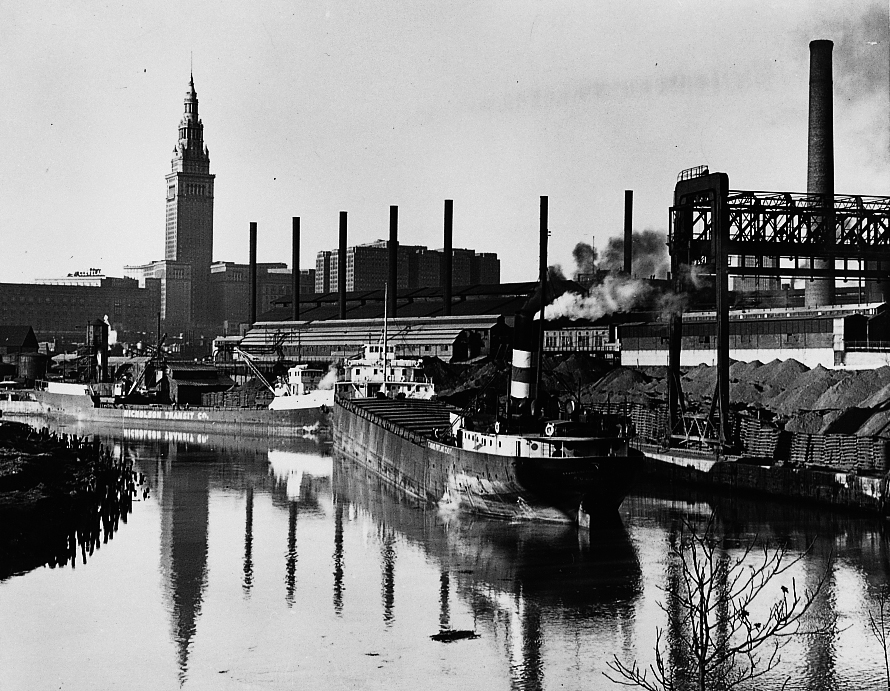
During the 1880’s and 1890’s, the city’s rapid industrial growth attracted many settlers from other countries. Most came from Hungary, Lithuania, Poland, or Russia. By 1900, 381,768 people lived in Cleveland.
Continued growth and progress.
During Tom L. Johnson’s term as mayor, from 1901 to 1909, Cleveland became one of the best-governed cities in the United States. Johnson improved the police department, and he brought about lower streetcar fares. He also developed a system of taxing owners of commercial property at a higher rate than homeowners.
The development of the automobile industry during the early 1900’s greatly aided steel manufacturing in Cleveland. After the United States entered World War I in 1917, the city made airplanes, ships, and tanks for the Allies. The rapid growth of the steel industry after the war helped Cleveland’s population hit 900,429 by 1930.
During World War II (1939-1945), the city again produced war materials. Thousands of people from other parts of the United States, including great numbers of African Americans from the South, came to Cleveland seeking work in the city’s defense industries. By 1950, Cleveland’s population had risen to 914,808.
Downturn and racial tensions.
A trend toward suburban living developed during the 1950’s, and thousands of white middle-class Clevelanders moved to newly built areas outside the city. Cleveland’s population fell to 876,050 by 1960.
The city faced serious racial problems in the 1960’s. In July 1966, four people were killed during a five-day riot in the Hough area. Racial tension decreased in 1967 after voters elected Carl B. Stokes mayor. Stokes, a Democrat, was the first Black mayor of a major U.S. city. He served until 1971. Another riot occurred in the Glenville area in July 1968. It resulted in 11 deaths.
Cleveland’s population declined dramatically in the 1960’s and 1970’s. By 1980, it had fallen to less than 574,000. During this period, the city lost thousands and thousands of jobs as industries declined or moved to the suburbs or other regions.
Financial problems.
Cleveland encountered severe financial difficulties during the 1970’s. In 1978, Cleveland became the first major U.S. city since the Great Depression of the 1930’s to default on (fail to pay when due) its loans. In 1979, voters approved an increase in the city income tax to help raise funds. Cleveland emerged from default in 1980 after city leaders and eight banks reached an agreement that enabled the city to repay its overdue loans.
Comeback City.
In the 1980’s, Cleveland worked to recover from its financial problems. The city’s efforts led to its being called the Comeback City.
To help achieve fiscal stability, the city government eliminated hundreds of city jobs, and voters approved another income tax increase. To improve political stability, voters approved a reduction of the City Council from 33 to 21 members and changed the terms of the mayor and council members from two years to four years. The number of jobs in manufacturing continued to drop, but service industries began to develop. Cleveland’s population loss slowed during the 1980’s. In 1990, the population leveled off at about 500,000.
The downtown area, including the lakefront, was the site of many redevelopment projects during the 1980’s and 1990’s. These projects included the development of the Tower City Center with its many retail and entertainment facilities, the renovation of Playhouse Square into a major performing-arts complex, and the development of the Gateway Sports and Entertainment Complex, which includes a baseball stadium and a basketball arena. Several new apartment and condominium complexes provided additional housing in the downtown area. The North Coast Harbor project transformed the lakefront with a harbor, a park, a sports stadium, and two museums.
Despite Cleveland’s economic comeback, the school system remained a source of concern. In 1995, after years of financial problems, the city’s school system was put under state control. But in 1997, the Ohio governor signed into law a bill giving responsibility to the Cleveland mayor, who officially took control in 1998. Goals for the school system included improving student scores on state tests, increasing parent involvement, and improving school safety.
Recent developments.
Cleveland emerged in the 2000’s with a substantially changed skyline and a new label, the New American City. But certain human issues continued to need attention, including race relations, public school reform, and job training for the unemployed.
In 2001, voters elected the city’s first female mayor, county commissioner and former state legislator Jane L. Campbell. In 2020, Cleveland had a population of 372,624, a decline of more than 20 percent since 2000.
